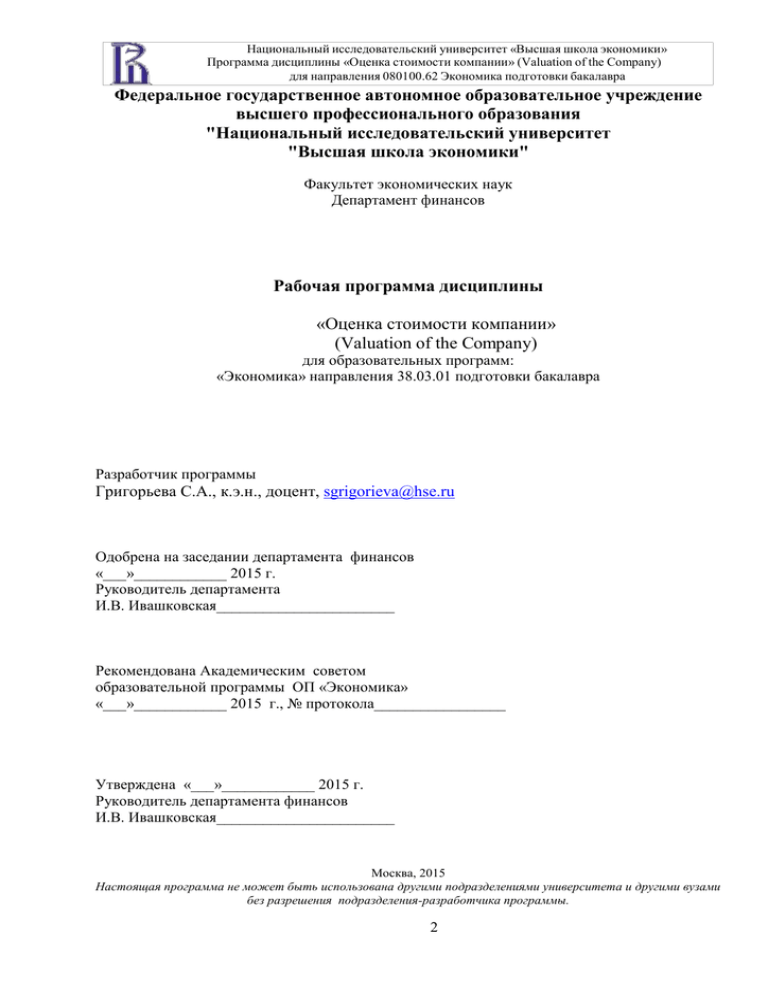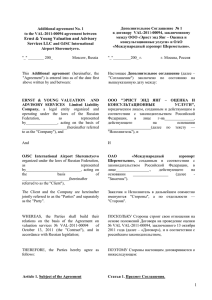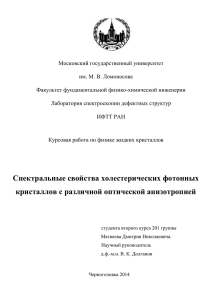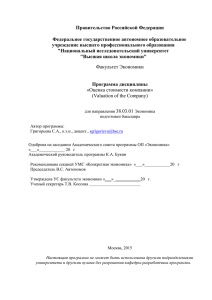valuation of the company
advertisement

Национальный исследовательский университет «Высшая школа экономики» Программа дисциплины «Оценка стоимости компании» (Valuation of the Company) для направления 080100.62 Экономика подготовки бакалавра Федеральное государственное автономное образовательное учреждение высшего профессионального образования "Национальный исследовательский университет "Высшая школа экономики" Факультет экономических наук Департамент финансов Рабочая программа дисциплины «Оценка стоимости компании» (Valuation of the Company) для образовательных программ: «Экономика» направления 38.03.01 подготовки бакалавра Разработчик программы Григорьева С.А., к.э.н., доцент, sgrigorieva@hse.ru Одобрена на заседании департамента финансов «___»____________ 2015 г. Руководитель департамента И.В. Ивашковская_______________________ Рекомендована Академическим советом образовательной программы ОП «Экономика» «___»____________ 2015 г., № протокола_________________ Утверждена «___»____________ 2015 г. Руководитель департамента финансов И.В. Ивашковская_______________________ Москва, 2015 Настоящая программа не может быть использована другими подразделениями университета и другими вузами без разрешения подразделения-разработчика программы. 2 Национальный исследовательский университет «Высшая школа экономики» Программа дисциплины «Оценка стоимости компании» (Valuation of the Company) для направления 080100.62 Экономика подготовки бакалавра 1 Компетенции обучающегося, формируемые в результате освоения дисциплины В результате освоения дисциплины студент должен: Знать Уметь Иметь навыки (приобрести опыт) В результате освоения дисциплины студент осваивает следующие компетенции: Компетенция Код по ФГОС/ НИУ Дескрипторы – основные признаки освоения (показатели достижения результата) Способен применять СК2 профессиональные знания и К-Б2 умения на практике Способен решать проблемы в СК4 профессиональной СК-Б4 деятельности на основе анализа и синтеза Умеет применять профессиональные знания и умения на практике Способен работать с информацией: находить, оценивать и использовать информацию из различных источников, необходимую для решения научных и профессиональных задач (в том числе на основе системного подхода) Способен собрать и проанализировать исходные данные, необходимые для расчета экономических и социально-экономических показателей, характеризующих деятельность хозяйствующих субъектов Способен на основе типовых методик и действующей нормативно-правовой базы рассчитать экономические и социально-экономические показатели, характеризующие деятельность хозяйствующих Способен выполнять необходимые для составления экономических разделов планов расчеты, СК6 СК-Б6 Работает с информацией: находит, оценивает и использует информацию из различных источников, необходимую для решения научных и профессиональных задач ПК9 ИКБ1.1_Б 4.1ПД1 (Э) Демонстрирует умение рассчитывать экономических и социальноэкономических показателей, характеризующих деятельность хозяйствующих субъектов Решать проблемы в профессиональной деятельности на основе анализа и синтеза ПК10 ИКБ4.3_4. 6_6.1 ПД1(Э ) Демонстрирует умение на основе типовых методик и действующей нормативно-правовой базы рассчитать экономические и социальноэкономические показатели, характеризующие деятельность хозяйствующих ПК11 Выполняет необходимые для ИКсоставления экономических разделов Б4.2_3.1_ планов расчеты, обосновывать их и 6.1_7.1П представлять результаты работы в 3 Формы и методы обучения, способствующие формированию и развитию компетенции Самостоятельная подготовка проекта по учебной дисциплине Решение практикоориентированных задач на семинарах. Представление результатов выполнения домашних заданий в форме рекомендаций по принятию решений. Самостоятельный поиск данных, которые будут использованы для оценки проектов и их презентации на семинарах. Изложение результатов самостоятельной работы на семинарских занятиях в форме защиты проектов, постановки вопросов и их обсуждении в аудитории. Самостоятельная подготовка проекта по учебной дисциплине Выполнение практических заданий и контрольной работы Национальный исследовательский университет «Высшая школа экономики» Программа дисциплины «Оценка стоимости компании» (Valuation of the Company) для направления 080100.62 Экономика подготовки бакалавра Компетенция Код по ФГОС/ НИУ обосновывать их и Д1(Э) представлять результаты работы в соответствии с принятыми в организации стандартами Способен осуществлять сбор, ПК15 анализ и обработку ИКстатистических данных, Б1.1_4. информации, научно1_4.3А аналитических материалов, Д_НИ Д(Э) необходимых для решения поставленных экономических задач Способен выбрать ПК16 инструментальные средства для обработки экономических данных в соответствии с поставленной задачей, проанализировать результаты расчетов и обосновать полученные выводы Способен анализировать и ПК18 интерпретировать финансовую, бухгалтерскую и иную информацию, содержащуюся в отчетности предприятий различных форм собственности, организаций, ведомств и т.д. и использовать полученные сведения для принятия управленческих решений Способен использовать для ПК21 решения аналитических и ИКисследовательских задач 4.1_4.2 современные технические _4.3_4. средства и информационные 4_4.6А технологии Д_НИ Д(Э) Способен критически ПК29 оценить предлагаемые варианты управленческих решений и разработать и обосновать предложения по их совершенствованию с учетом критериев социальноэкономической эффективности, рисков и возможных социальноэкономических последствий Дескрипторы – основные признаки освоения (показатели достижения результата) Формы и методы обучения, способствующие формированию и развитию компетенции соответствии с принятыми в организации стандартами Демонстрирует умение осуществлять сбор, анализ и обработку статистических данных, информации, научно-аналитических материалов, необходимых для решения поставленных экономических задач Самостоятельная подготовка проекта по учебной дисциплине Применяет известный математический аппарат для решения типовых математических задач, возникающих в области данной дисциплины. Решение задач Умеет анализировать и интерпретировать финансовую, бухгалтерскую и иную информацию, содержащуюся в отчетности предприятий различных форм собственности Изложение результатов самостоятельной работы на семинарских занятиях в форме защиты проектов, постановки вопросов и их обсуждении в аудитории. Использует для решения аналитических и исследовательских задач современные технические средства и информационные технологии Самостоятельный поиск, изучение и использование данных на практических и семинарских занятиях Критически оценивает предлагаемые варианты управленческих решений и разрабатывает предложения по их совершенствованию с учетом критериев социально-экономической эффективности, рисков и возможных социально-экономических последствий Изложение результатов самостоятельной работы на семинарских занятиях в форме защиты проектов, постановки вопросов и их обсуждении в аудитории. 4 National Research University Higher School of Economics Valuation of the Company Syllabus VALUATION OF THE COMPANY Bachelor level Coordinator: Svetlana A. Grigorieva Lecturers: Svetlana A. Grigorieva, Ekaterina Izutova (E&Y), Alexey Fedotov (E&Y), Alexander Kopylov (E&Y) Course description: The course will introduce students to the most frequently used quantitative valuation techniques. The main topics covered include (1) discounted cash flow methods (2) relative valuation using multiples (3) asset-based approach. Particular attention is paid to evaluation of individual groups of assets under the net asset value method: financial assets, real estate, tangible real property, intangible assets. The focus of the course is on the evaluation of companies in emerging capital markets. Students will learn how to conduct firm valuation in terms of high levels of macroeconomic uncertainty, illiquid capital markets, and high levels of political risks. Participants are provided with the opportunity to work in small teams and value different groups of assets and firms in emerging capital markets. The course is taught in collaboration with the managers and partners of Ernst & Young Company. Course objectives: After completing the course the student will be able to: • understand the main steps of business valuation; • apply different valuation techniques such as Dividend-models, FCFF, FCFE, relative valuation and asset based valuation; • apply the primary methods to measure value of different groups of company assets; • understand the importance and apply the discounts and premiums in business valuation (control premium, discount for lack of control, discount for lack of marketability) • identify and analyze a company’s value drivers and relate these drivers to the value enhancement process; • understand the features of corporate valuation in emerging capital markets. Competencies: After completing the course the student develops the following competencies: • is willing to work with information from a variety of sources (ИК- 4) – analytical tasks that assume the calculation of company's valuation ratios based on the data from financial statements; • is willing to work in teams (СЛК-7) – cases, analytical tasks based on real information; • is able to apply traditional valuation methods (ПК-2) – cases, practical exercises, analytical tasks; • is able to analyse and interpret financial and analytical information, work with data from company’s financial statements (ПК-7) – cases, practical exercises, analytical tasks. • is able to get and use the necessary information from open excess to apply it to business valuation (ПК-4) – cases, analytical tasks. Recommended Prerequisites: Statistics, Microeconomics, Corporate Finance-1, Accounting. National Research University Higher School of Economics Valuation of the Company Teaching method: • • • • • • • lectures; practical exercises; case studies; analytical tasks; team projects; self study; final exam. Course texts: Main texts: 1. 2. Hitchner J.R., Financial Valuation: Applications and Models, 3rd edition, John Wiley&Sons, 2011, (hse electronic library «ebrary») Damodaran A., Investment Valuation: Tools and Techniques for Determining the Value of any Asset, 3rd edition, John Wiley&Sons, 2012, (hse electronic library «Books 24x7») Supplementary texts: 1. Koller T., Goedhart M., Wessels D., Valuation: measuring and managing the value of companies, 5th edition, John Wiley&Sons, 2010, (hse electronic library «Books 24x7») 2. Pratt S.P., Reilly R.F., Schweihs R.P., Valuing a Business: The Analysis and Appraisal of Closely Held Companies, McGraw-Hill Co., 2000, (hse electronic library «Books 24x7») 3. 4. 5. 6. 7. Pratt S.P., Niculita A.V., Valuing a Business: The Analysis and Appraisal of Closely Held Companies, 5th Edition, McGraw-Hill Co., 2008. Mard M.J., Hitchner J.R., Hyden S.D., Valuation for financial reporting: fair value measurements and reporting, intangible assets, goodwill and impairment, 2nd Edition, John Willey&Sons, 2007, (hse electronic library «Books 24x7») King A.M., Fair value for financial reporting: meeting the new FASB requirements, John Wiley&Sons, 2006, (hse electronic library «Books 24x7») Reilly Robert, Schweihs Robert. Valuing Intangible Assets. IRWIN Library of Investment Finance. McGraw-Hill, 2001. The Appraisal of Real Estate, 13th Edition, Thirteenth Edition Appraisal Institute, 2008 8. Valuing Machinery and equipment: the fundamentals of appraising machinery and technical assets / by Machinery and Technical Specialties Committee of the American Society of Appraisers.- 2nd ed., 2005 9. Estridge J., Lougee B. Measuring Free Cash Flows for Equity Valuation: Pitfalls and Possible Solutions. Journal of Applied Corporate Finance, Vol.19, №.2, 2007, pp.60-71 10. Garcia-Sanchez J., Preve L., Sarria-Allende V., Valuation in Emerging Markets: A Simulation Approach. Journal of Applied Corporate Finance, Vol.22, №2, 2010, pp.100-108 11. Pereiro L.,E., The Valuation of Closely-held Companies in Latin America, Emerging Markets Review, Vol.2, 2001, pp. 2213-2253 12. Luehrman T.A., Corporate Valuation and Market Multiples, Harvard Business Review, №16, 2009. 13. Fernandez P., 80 common and uncommon errors in company valuation, IESE Research Papers D/550, IESE Business School, 2004. 14. Russian Federal Low on Valuation № 135-ФЗ – www.consultant.ru National Research University Higher School of Economics Valuation of the Company 15. Russian Federal Valuation Standards 1-6 – www.consultant.ru. Grading: • • • Grading in the course will be based on the following criteria: Class participation 20% Team projects 45% Final exam 35% Total 100% Grades criteria: From To Mark 0 4 Not passed 4 5 Satisfactory 6 7 Good 8 10 Excellent Teaching hours for topics and activities: Topic 1. Introduction to Valuation Total (hours) Class (hours) including Lectures Practice Self study 16 4 36 8 8 20 28 4 8 16 34 4 E&Y 8 22 5. Cost approach: individual asset valuation procedures 48 12 E&Y 8 28 Total: 162 32 32 98 4 2. Income approach: discounted cash flow methods, capitalization method 3. Market approach: public company method, merger and acquisition method 4. Cost approach: net asset value method, liquidation value method 12 Exam - 2 Essay - 1 Of the week - 3 Credit unit – 4,5 Course outline: 1. Introduction to Valuation. Business valuation legal and regulatory environment. Business valuation standards. The role and the process of valuation. Types of firm value: market value, fair value, National Research University Higher School of Economics Valuation of the Company investment value, intrinsic value, liquidation value, book value. Business valuation approaches and methods. Valuation across the life cycle of the firm. The main steps of corporate valuation. The impact of controlling (noncontrolling) ownership interest and marketability on company value: discount for lack of control and discount for lack of marketability. The structure of business valuation report. Necessary information to conduct business valuation: company specific data, data about the company's industry and economic environment. Financial review and pro forma analysis. Main texts: National Research University Higher School of Economics Valuation of the Company 1. Hitchner J.R., Financial Valuation: Applications and Models, 3rd edition, John Wiley&Sons, 2011, (hse electronic library «ebrary») – Ch.1-3 2. Damodaran A., Investment Valuation: Tools and Techniques for Determining the Value of any Asset, 3rd edition, John Wiley&Sons, 2012, (hse electronic library «Books 24x7») – Ch. 1-3 3. Russian Federal Low on Valuation № 135-ФЗ 29.07.1998 г. – www.consultant.ru 4. Russian Federal Valuation Standards 1-6 – www.consultant.ru Supplementary texts: 1. Pratt S.P., Reilly R.F., Schweihs R.P., Valuing a Business: The Analysis and Appraisal of Closely Held Companies, McGraw-Hill Co., 2008 (hse electronic library «Books 24x7») – Ch.3,3,7,8. 2. Income approach: discounted cash flow methods, capitalization method. Dividend discount models: assumptions and limitations. Free cash flow to equity (FCFE) discount models. Free cash flow to firm (FCFF) discount models. Building a financial model: length of the high growth period, forecasting future performance, the main models of estimating terminal value. Forecasting financial performance: prepare pro forma financial statements for the planning period, convert pro forma financial statements to cash flow forecasts, estimate the terminal value of firm FCF. The equity premium and the cost of capital. The capital asset pricing model (CAPM) approach. The Fama-French three-factor model. Arbitrage pricing theory. Build-up model. The cost of equity of large (small) capitalization companies. The cost of debt and other components of the capital structure. Estimation of the cost of capital in practice. Valuation issues specific to emerging capital markets: effects of inflation on financial analysis, incorporating emerging market risks in valuation. Calculating the cost of capital in emerging markets: the CAPM-spread model. Capitalization method. Difference between capitalization rate and discount rate. Limitations of the method. Main texts: 1. Hitchner J.R., Financial Valuation: Applications and Models, 3rd edition, John Wiley&Sons, 2011, (hse electronic library «ebrary») – Ch.4,5 2. Damodaran A., Investment Valuation: Tools and Techniques for Determining the Value of any Asset, 3rd edition, John Wiley&Sons, 2012, (hse electronic library «Books 24x7») – Ch. 716 Supplementary texts: 1. Koller T., Goedhart M., Wessels D., Valuation: measuring and managing the value of companies, 5th edition, John Wiley&Sons, 2010, (hse electronic library «Books 24x7») – Ch.6-13 2. Pratt S.P., Reilly R.F., Schweihs R.P., Valuing a Business: The Analysis and Appraisal of Closely Held Companies, McGraw-Hill Co., 2008 (hse electronic library «Books 24x7») – Ch.9,10. 3. Estridge J., Lougee B. Measuring Free Cash Flows for Equity Valuation: Pitfalls and Possible Solutions. Journal of Applied Corporate Finance, Vol.19, N.2 4. Garcia-Sanchez J., Preve L., Sarria-Allende V., Valuation in Emerging Markets: A Simulation Approach. Journal of Applied Corporate Finance, Vol.22, №2, 2010, pp.100-108 5. Pereiro L.,E., The Valuation of Closely-held Companies in Latin America, Emerging Markets Review, Vol.2, 2001, pp. 2213-2253 9 National Research University Higher School of Economics Valuation of the Company 3. Market approach: public company method, merger and acquisition method. Fundamental principals of relative valuation. Difference between public company method and merger and acquisition method. Basic steps of relative valuation. Criteria for comparable company selection. The most commonly used multiples and its determinants: P/E, EV/S, EV/EBITDA, P/BV. Sector multiples. Multiples and continuation value. Adjusting multiples for leverage and growth. Pitfalls of relative valuation. Relative valuation in emerging capital markets. Factors affecting valuation ratios. Main texts: 1. Hitchner J.R., Financial Valuation: Applications and Models, 3rd edition, John Wiley&Sons, 2011, (hse electronic library «ebrary») – Ch.6. 2. Damodaran A., Investment Valuation: Tools and Techniques for Determining the Value of any Asset, 3rd edition, John Wiley&Sons, 2012, (hse electronic library «Books 24x7») – Ch. 1720 Supplementary texts: 1. Koller T., Goedhart M., Wessels D., Valuation: measuring and managing the value of companies, 5th edition, John Wiley&Sons, 2010, (hse electronic library «Books 24x7») – Ch.14 2. Pratt S.P., Reilly R.F., Schweihs R.P., Valuing a Business: The Analysis and Appraisal of Closely Held Companies, McGraw-Hill Co., 2008 (hse electronic library «Books 24x7») – Ch.11,12. 3. Luehrman T.A., Corporate Valuation and Market Multiples, Harvard Business Review, №16, 2009. 4. Cost approach: net asset value method, liquidation value method. Fundamentals of cost approach. Cost approach versus book value. Main steps of net asset value method. Identify assets and liabilities to be revalued. Construct a value-basis balance sheet. Liquidation value method. Using cost approach for IFRS and US GAAP financial statement preparation: allocation of purchase price in M&A deal. Goodwill. Advantages and disadvantages of cost approach. Main texts: 1. Hitchner J.R., Financial Valuation: Applications and Models, 3rd edition, John Wiley&Sons, 2011, (hse electronic library «ebrary») – Ch.7, 21. Supplementary texts: 1. Pratt S.P., Reilly R.F., Schweihs R.P., Valuing a Business: The Analysis and Appraisal of Closely Held Companies, McGraw-Hill Co., 2008 (hse electronic library «Books 24x7») – Ch.14. 5. Cost approach: individual asset valuation procedures. Valuation of intangible assets. Identification and classification of intangible assets. Income approach: royalty method, multi-period excess earnings method (MEEM), differential method, greenfield method. Market approach. Cost approach. Intangible asset valuation in practice. Real estate valuation. Real estate classification. Necessary information to conduct real estate valuation. Income approach: discounted cash flow method, capitalization method. Potential gross income, net operating income, discount rate calculation. Market approach. Basic steps of cost approach. Accounting depreciation versus appraisal depreciation. Types of depreciation: physical depreciation, functional obsolescence, economic obsolescence. Depreciation estimates. Real estate valuation in practice. Machinery and equipment valuation. Machinery and equipment classification. The life cycle of the equipment. The influence of different types of depreciation on machinery and 1 0 National Research University Higher School of Economics Valuation of the Company equipment valuation. Market approach. Cost approach. Income approach. Machinery and equipment valuation in practice. Main texts: 1. Hitchner J.R., Financial Valuation: Applications and Models, 3rd edition, John Wiley&Sons, 2011, (hse electronic library «ebrary») – Ch.7, 21. 2. Damodaran A., Investment Valuation: Tools and Techniques for Determining the Value of any Asset, 3rd edition, John Wiley&Sons, 2012, (hse electronic library «Books 24x7») – Ch.26 Supplementary texts: 1. Pratt S.P., Reilly R.F., Schweihs R.P., Valuing a Business: The Analysis and Appraisal of Closely Held Companies, McGraw-Hill Co., 2008 (hse electronic library «Books 24x7») – Ch.14. 2. Mard M.J., Hitchner J.R., Hyden S.D., Valuation for financial reporting: fair value measurements and reporting, intangible assets, goodwill and impairment, 2nd Edition, John Willey&Sons, 2007, (hse electronic library «Books 24x7») 3. King A.M., Fair value for financial reporting: meeting the new FASB requirements, John Wiley&Sons, 2006, (hse electronic library «Books 24x7»)-Ch.9 4. Reilly Robert, Schweihs Robert. Valuing Intangible Assets. IRWIN Library of Investment Finance. McGraw-Hill, 2001. 5. The Appraisal of Real Estate, 13th Edition, Thirteenth Edition Appraisal Institute, 2008 6. Valuing Machinery and equipment: the fundamentals of appraising machinery and technical assets / by Machinery and Technical Specialties Committee of the American Society of Appraisers.- 2nd ed., 2005 1 1


